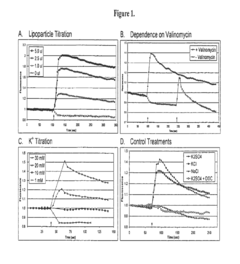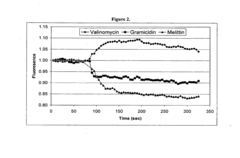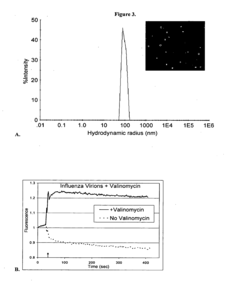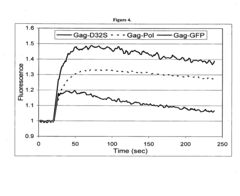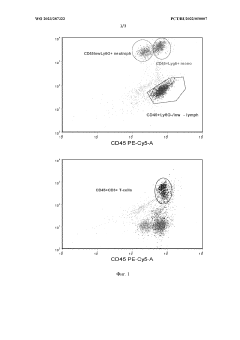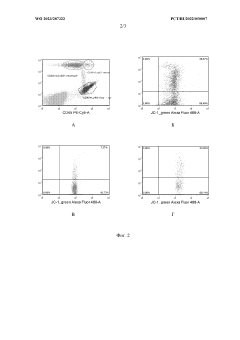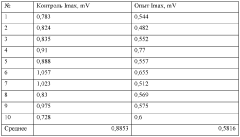The interaction between isotonic solutions and cell membrane potentials
AUG 19, 20259 MIN READ
Generate Your Research Report Instantly with AI Agent
Patsnap Eureka helps you evaluate technical feasibility & market potential.
Isotonic Solutions and Membrane Potentials: Background
The study of isotonic solutions and their interaction with cell membrane potentials has been a cornerstone of cellular biology and physiology for decades. This field of research has its roots in the early 20th century when scientists began to unravel the complex relationships between cellular environments and the electrical properties of cell membranes.
Isotonic solutions are defined as having the same osmotic pressure as the cell's cytoplasm, maintaining a delicate balance that prevents excessive water movement in or out of the cell. This concept is crucial for understanding cellular homeostasis and the mechanisms that govern the transport of substances across cell membranes.
The cell membrane potential, on the other hand, refers to the electrical potential difference between the interior and exterior of a cell. This potential is primarily maintained by the unequal distribution of ions across the membrane and the selective permeability of the membrane to these ions. The resting membrane potential of most cells typically ranges from -40 to -80 millivolts, with the inside of the cell being negative relative to the outside.
The interaction between isotonic solutions and membrane potentials is a complex and dynamic process. When cells are exposed to isotonic solutions, they maintain their volume and shape due to the balanced osmotic pressure. However, the composition of these solutions can significantly influence the membrane potential by altering the concentration gradients of key ions such as sodium, potassium, and chloride.
Understanding this interaction is critical for various physiological processes, including nerve signal transmission, muscle contraction, and the regulation of cellular metabolism. It also has profound implications for medical treatments, particularly in the formulation of intravenous fluids and the development of drugs that target ion channels or transporters.
Over the years, research in this area has evolved from basic observations to sophisticated experimental techniques and mathematical models. Advanced electrophysiological methods, such as patch-clamp techniques, have allowed scientists to measure membrane potentials with unprecedented accuracy. Simultaneously, the development of fluorescent dyes and imaging technologies has enabled real-time visualization of ion movements and membrane potential changes in living cells.
The field continues to expand, with recent advances in molecular biology and genetics providing new insights into the structure and function of membrane proteins involved in maintaining ionic balance and generating membrane potentials. This ongoing research not only deepens our understanding of fundamental cellular processes but also opens new avenues for therapeutic interventions in various diseases related to ion imbalances and membrane dysfunction.
Isotonic solutions are defined as having the same osmotic pressure as the cell's cytoplasm, maintaining a delicate balance that prevents excessive water movement in or out of the cell. This concept is crucial for understanding cellular homeostasis and the mechanisms that govern the transport of substances across cell membranes.
The cell membrane potential, on the other hand, refers to the electrical potential difference between the interior and exterior of a cell. This potential is primarily maintained by the unequal distribution of ions across the membrane and the selective permeability of the membrane to these ions. The resting membrane potential of most cells typically ranges from -40 to -80 millivolts, with the inside of the cell being negative relative to the outside.
The interaction between isotonic solutions and membrane potentials is a complex and dynamic process. When cells are exposed to isotonic solutions, they maintain their volume and shape due to the balanced osmotic pressure. However, the composition of these solutions can significantly influence the membrane potential by altering the concentration gradients of key ions such as sodium, potassium, and chloride.
Understanding this interaction is critical for various physiological processes, including nerve signal transmission, muscle contraction, and the regulation of cellular metabolism. It also has profound implications for medical treatments, particularly in the formulation of intravenous fluids and the development of drugs that target ion channels or transporters.
Over the years, research in this area has evolved from basic observations to sophisticated experimental techniques and mathematical models. Advanced electrophysiological methods, such as patch-clamp techniques, have allowed scientists to measure membrane potentials with unprecedented accuracy. Simultaneously, the development of fluorescent dyes and imaging technologies has enabled real-time visualization of ion movements and membrane potential changes in living cells.
The field continues to expand, with recent advances in molecular biology and genetics providing new insights into the structure and function of membrane proteins involved in maintaining ionic balance and generating membrane potentials. This ongoing research not only deepens our understanding of fundamental cellular processes but also opens new avenues for therapeutic interventions in various diseases related to ion imbalances and membrane dysfunction.
Market Analysis of Isotonic Solutions
The market for isotonic solutions has experienced significant growth in recent years, driven by increasing applications in healthcare, sports nutrition, and research settings. These solutions, which maintain osmotic balance with cell membranes, play a crucial role in various medical procedures, including intravenous therapy, dialysis, and wound care. The global isotonic solutions market is expected to continue its upward trajectory, with a compound annual growth rate projected to exceed 5% over the next five years.
In the healthcare sector, isotonic solutions are widely used for fluid replacement, electrolyte balance, and as a medium for drug delivery. The rising prevalence of chronic diseases, coupled with an aging population, has led to increased demand for intravenous therapies and dialysis treatments, thereby boosting the market for isotonic solutions. Additionally, the growing emphasis on personalized medicine and targeted drug delivery systems has opened new avenues for specialized isotonic formulations.
The sports nutrition segment has emerged as a significant driver of market growth. Athletes and fitness enthusiasts increasingly recognize the importance of proper hydration and electrolyte balance for optimal performance and recovery. This has led to a surge in demand for isotonic sports drinks and recovery solutions, with major beverage companies investing heavily in research and development to create innovative products that cater to specific athletic needs.
In the research and biotechnology sector, isotonic solutions are essential for cell culture and tissue engineering applications. The expanding field of regenerative medicine and the increasing focus on stem cell research have created a steady demand for high-quality, specialized isotonic media. This trend is expected to continue as advancements in biomedical research drive the need for more sophisticated cell culture techniques.
Geographically, North America and Europe currently dominate the isotonic solutions market, owing to their advanced healthcare infrastructure and high healthcare expenditure. However, the Asia-Pacific region is anticipated to witness the fastest growth in the coming years, fueled by improving healthcare access, rising disposable incomes, and increasing awareness about health and wellness.
The market landscape is characterized by a mix of established pharmaceutical companies and specialized manufacturers. Key players are focusing on product innovation, strategic partnerships, and geographical expansion to gain a competitive edge. The development of novel isotonic formulations that offer enhanced stability, biocompatibility, and targeted delivery capabilities is a major focus area for industry research and development efforts.
In the healthcare sector, isotonic solutions are widely used for fluid replacement, electrolyte balance, and as a medium for drug delivery. The rising prevalence of chronic diseases, coupled with an aging population, has led to increased demand for intravenous therapies and dialysis treatments, thereby boosting the market for isotonic solutions. Additionally, the growing emphasis on personalized medicine and targeted drug delivery systems has opened new avenues for specialized isotonic formulations.
The sports nutrition segment has emerged as a significant driver of market growth. Athletes and fitness enthusiasts increasingly recognize the importance of proper hydration and electrolyte balance for optimal performance and recovery. This has led to a surge in demand for isotonic sports drinks and recovery solutions, with major beverage companies investing heavily in research and development to create innovative products that cater to specific athletic needs.
In the research and biotechnology sector, isotonic solutions are essential for cell culture and tissue engineering applications. The expanding field of regenerative medicine and the increasing focus on stem cell research have created a steady demand for high-quality, specialized isotonic media. This trend is expected to continue as advancements in biomedical research drive the need for more sophisticated cell culture techniques.
Geographically, North America and Europe currently dominate the isotonic solutions market, owing to their advanced healthcare infrastructure and high healthcare expenditure. However, the Asia-Pacific region is anticipated to witness the fastest growth in the coming years, fueled by improving healthcare access, rising disposable incomes, and increasing awareness about health and wellness.
The market landscape is characterized by a mix of established pharmaceutical companies and specialized manufacturers. Key players are focusing on product innovation, strategic partnerships, and geographical expansion to gain a competitive edge. The development of novel isotonic formulations that offer enhanced stability, biocompatibility, and targeted delivery capabilities is a major focus area for industry research and development efforts.
Current Challenges in Membrane Potential Research
Research in membrane potential faces several significant challenges that hinder our comprehensive understanding of cellular electrical activity. One primary obstacle is the complexity of measuring membrane potentials in living cells with high spatial and temporal resolution. Current techniques, such as patch-clamp electrophysiology, while precise, are invasive and limited to single-cell measurements. This constraint makes it difficult to study the dynamic interactions between multiple cells or within tissue networks.
Another challenge lies in the heterogeneity of cell populations. Even within the same tissue, individual cells can exhibit diverse membrane potential characteristics, making it challenging to draw generalized conclusions. This variability necessitates the development of more sophisticated analytical tools and statistical methods to interpret data accurately.
The interaction between isotonic solutions and cell membrane potentials presents its own set of challenges. While isotonic solutions are designed to maintain cellular osmotic balance, their effects on membrane potentials are not always straightforward. Subtle changes in ion concentrations or the presence of specific solutes can lead to unexpected alterations in membrane potential. Researchers struggle to isolate these effects from other cellular processes, complicating the interpretation of experimental results.
Furthermore, the dynamic nature of membrane potentials poses difficulties in long-term studies. Membrane potentials can fluctuate rapidly in response to various stimuli, making it challenging to capture and analyze these changes over extended periods. This limitation is particularly problematic when investigating slow-acting processes or chronic conditions that may influence membrane potentials over time.
The development of non-invasive measurement techniques remains a significant challenge. While fluorescent voltage-sensitive dyes have shown promise, they often suffer from phototoxicity and can alter cellular physiology. Additionally, these dyes may not accurately reflect absolute membrane potential values, limiting their utility in quantitative studies.
Lastly, the integration of membrane potential data with other cellular parameters, such as metabolic activity, gene expression, or protein function, presents a multidisciplinary challenge. Researchers must develop new methodologies and analytical frameworks to correlate electrical activity with broader cellular processes, providing a more holistic understanding of cell physiology.
Another challenge lies in the heterogeneity of cell populations. Even within the same tissue, individual cells can exhibit diverse membrane potential characteristics, making it challenging to draw generalized conclusions. This variability necessitates the development of more sophisticated analytical tools and statistical methods to interpret data accurately.
The interaction between isotonic solutions and cell membrane potentials presents its own set of challenges. While isotonic solutions are designed to maintain cellular osmotic balance, their effects on membrane potentials are not always straightforward. Subtle changes in ion concentrations or the presence of specific solutes can lead to unexpected alterations in membrane potential. Researchers struggle to isolate these effects from other cellular processes, complicating the interpretation of experimental results.
Furthermore, the dynamic nature of membrane potentials poses difficulties in long-term studies. Membrane potentials can fluctuate rapidly in response to various stimuli, making it challenging to capture and analyze these changes over extended periods. This limitation is particularly problematic when investigating slow-acting processes or chronic conditions that may influence membrane potentials over time.
The development of non-invasive measurement techniques remains a significant challenge. While fluorescent voltage-sensitive dyes have shown promise, they often suffer from phototoxicity and can alter cellular physiology. Additionally, these dyes may not accurately reflect absolute membrane potential values, limiting their utility in quantitative studies.
Lastly, the integration of membrane potential data with other cellular parameters, such as metabolic activity, gene expression, or protein function, presents a multidisciplinary challenge. Researchers must develop new methodologies and analytical frameworks to correlate electrical activity with broader cellular processes, providing a more holistic understanding of cell physiology.
Existing Methods for Measuring Membrane Potentials
01 Composition of isotonic solutions for maintaining cell membrane potentials
Isotonic solutions are formulated to maintain cell membrane potentials by balancing electrolyte concentrations. These solutions typically contain a mixture of salts and other compounds that mimic the osmolarity of body fluids, preventing cell shrinkage or swelling. The careful balance of ions such as sodium, potassium, and chloride is crucial for preserving cellular function and membrane integrity.- Composition of isotonic solutions for maintaining cell membrane potentials: Isotonic solutions are formulated to maintain cell membrane potentials by balancing electrolyte concentrations. These solutions typically contain a mixture of salts and other compounds that mimic the osmolarity of body fluids, preventing cell shrinkage or swelling. The composition may include sodium chloride, potassium chloride, and other electrolytes in specific ratios to maintain cellular homeostasis.
- Methods for measuring and monitoring cell membrane potentials in isotonic environments: Various techniques are employed to measure and monitor cell membrane potentials in isotonic solutions. These may include electrophysiological methods, fluorescent dye-based assays, or advanced imaging techniques. Such measurements are crucial for understanding cellular responses to isotonic conditions and for developing improved formulations for maintaining optimal cell function.
- Applications of isotonic solutions in cell culture and tissue preservation: Isotonic solutions play a vital role in cell culture systems and tissue preservation techniques. They are used to create environments that closely mimic physiological conditions, allowing for the maintenance of cell viability and function during in vitro studies or organ transplantation procedures. These solutions are carefully formulated to support cellular metabolism and prevent osmotic stress.
- Impact of isotonic solutions on ion channel function and membrane transport: The use of isotonic solutions affects ion channel function and membrane transport processes. These solutions can modulate the activity of various ion channels and transporters, influencing cellular signaling and homeostasis. Understanding these interactions is crucial for developing targeted therapies and optimizing cellular function in experimental and clinical settings.
- Development of novel isotonic formulations for specific cell types or conditions: Research focuses on developing specialized isotonic formulations tailored to specific cell types or physiological conditions. These may include solutions optimized for neurons, cardiac cells, or cells under stress conditions. Novel additives or modified electrolyte compositions are explored to enhance cell survival, function, and resilience in various experimental or therapeutic contexts.
02 Measurement and analysis of cell membrane potentials in isotonic environments
Various techniques and devices are employed to measure and analyze cell membrane potentials in isotonic solutions. These methods may include patch-clamp techniques, fluorescent voltage-sensitive dyes, or ion-selective electrodes. Advanced analytical tools and software are used to interpret the data, providing insights into cellular physiology and the effects of isotonic conditions on membrane potentials.Expand Specific Solutions03 Applications of isotonic solutions in biomedical research and clinical settings
Isotonic solutions play a crucial role in various biomedical research applications and clinical settings. They are used in cell culture media, organ preservation solutions, and intravenous fluids. These solutions help maintain cellular integrity and function during experiments, transplantation procedures, and medical treatments. The specific composition of isotonic solutions may be tailored to different cell types or tissues to optimize their effectiveness.Expand Specific Solutions04 Impact of isotonic solutions on ion channel activity and membrane transport
Isotonic solutions influence ion channel activity and membrane transport processes. The composition of these solutions affects the behavior of voltage-gated and ligand-gated ion channels, as well as various membrane transporters. Understanding these interactions is crucial for studying cellular signaling, neurotransmission, and other physiological processes that rely on the maintenance of proper membrane potentials.Expand Specific Solutions05 Development of novel isotonic formulations for specific cellular applications
Researchers are developing new isotonic formulations tailored for specific cellular applications. These may include solutions optimized for particular cell types, tissue engineering constructs, or specialized medical procedures. Novel additives or modified electrolyte compositions are being explored to enhance the performance of isotonic solutions in maintaining cell membrane potentials under various conditions or for extended periods.Expand Specific Solutions
Key Players in Cellular Biophysics
The interaction between isotonic solutions and cell membrane potentials represents a mature field of research within cellular physiology. The market for related technologies and applications is well-established, with steady growth driven by ongoing biomedical research and pharmaceutical development. Key players in this space include academic institutions like The University of Chicago and Yale University, as well as major pharmaceutical and biotechnology companies such as Novartis, Johnson & Johnson, and Vertex Pharmaceuticals. These organizations leverage advanced electrophysiology techniques and molecular biology tools to study membrane dynamics. While fundamental research continues, the technology is considered relatively mature, with innovations focused on improving sensitivity, throughput, and integration with other cellular analysis methods.
The Regents of the University of California
Technical Solution: The University of California has developed advanced techniques for studying the interaction between isotonic solutions and cell membrane potentials. They utilize patch-clamp electrophysiology to measure changes in membrane potential with high temporal resolution[1]. Their approach combines microfluidics with electrophysiology, allowing precise control of the extracellular environment while simultaneously recording membrane potentials[2]. This enables detailed characterization of how isotonic solutions affect ion channel activity and membrane polarization. The university has also pioneered the use of fluorescent voltage-sensitive dyes to visualize membrane potential changes across entire cell populations in response to isotonic solutions[3]. Their multi-pronged approach provides comprehensive insights into the complex dynamics between isotonic solutions and cellular electrophysiology.
Strengths: Cutting-edge techniques combining electrophysiology, microfluidics and optical imaging. Weaknesses: Highly specialized equipment and expertise required, potentially limiting widespread adoption.
The Trustees of Columbia University in The City of New York
Technical Solution: Columbia University has developed innovative methods to study isotonic solution-membrane interactions using artificial cell membrane systems. Their approach utilizes planar lipid bilayers as model membranes, allowing precise control and measurement of membrane potentials[1]. By reconstituting purified ion channels and transporters into these artificial membranes, they can isolate and characterize specific protein-mediated effects of isotonic solutions[2]. Columbia researchers have also pioneered the use of giant unilamellar vesicles (GUVs) as cell-sized membrane models to study osmotic effects on membrane tension and curvature[3]. Additionally, they employ advanced spectroscopic techniques like fluorescence correlation spectroscopy to probe molecular-level interactions between solutes in isotonic solutions and membrane components[4]. This multi-scale approach provides a comprehensive understanding of how isotonic solutions influence membrane potentials and structure.
Strengths: Highly controlled experimental systems allowing isolation of specific mechanisms. Weaknesses: Artificial systems may not fully recapitulate the complexity of living cell membranes.
Innovations in Isotonic Solution Formulations
Lipoparticles comprising ion channels, methods of making and using the same
PatentInactiveUS20130244222A1
Innovation
- Development of lipoparticles comprising ion channel polypeptides and membrane potential-sensitive dyes, allowing for the detection of changes in membrane potential and ion channel activity using fluorescent probes, enabling high-throughput screening of ion channel modulators and inhibitors.
Agent for correcting mitochondrial dysfunction
PatentWO2023287322A1
Innovation
- An immunomodulating agent containing formic aldehyde in an isotonic sodium chloride solution is administered intramuscularly to increase mitochondrial membrane potential and oxygen-dependent metabolism of neutrophils.
Regulatory Aspects of Isotonic Solutions
The regulatory landscape surrounding isotonic solutions is complex and multifaceted, reflecting the critical role these solutions play in medical and pharmaceutical applications. Regulatory bodies worldwide, such as the FDA in the United States and the EMA in Europe, have established stringent guidelines for the production, testing, and use of isotonic solutions. These regulations primarily focus on ensuring the safety, efficacy, and quality of these solutions, particularly when used in clinical settings.
One of the key regulatory aspects is the requirement for precise osmolality control. Isotonic solutions must maintain an osmolality close to that of human blood (285-295 mOsm/kg) to prevent adverse effects on cell membrane potentials. Regulatory agencies mandate strict testing protocols to verify the osmolality of these solutions before approval and release. Additionally, manufacturers must demonstrate consistency in production processes to ensure batch-to-batch uniformity.
The purity of ingredients used in isotonic solutions is another critical regulatory concern. Regulatory bodies require extensive documentation on the sourcing, quality control, and testing of all components. This includes rigorous standards for water quality, as even minute impurities can significantly affect the solution's interaction with cell membranes. Manufacturers must implement and maintain robust quality management systems to comply with Good Manufacturing Practices (GMP) guidelines.
Stability testing is a crucial regulatory requirement for isotonic solutions. Manufacturers must provide data demonstrating the solution's stability over time under various storage conditions. This includes assessing potential changes in osmolality, pH, and chemical composition that could affect the solution's interaction with cell membranes. Regulatory agencies often require long-term stability studies to support shelf-life claims.
Labeling and packaging regulations for isotonic solutions are also stringent. Labels must clearly state the solution's composition, osmolality, and intended use. Any warnings or precautions related to potential effects on cell membrane potentials must be prominently displayed. Packaging materials must be proven inert and non-reactive with the solution to prevent contamination or alteration of the solution's properties.
Regulatory bodies also focus on the clinical application of isotonic solutions. Manufacturers seeking approval for new formulations or applications must provide extensive clinical data demonstrating safety and efficacy. This often includes studies on the solution's effects on cell membrane potentials in various physiological states. Post-market surveillance is typically required to monitor for any unexpected interactions or adverse effects in real-world use.
One of the key regulatory aspects is the requirement for precise osmolality control. Isotonic solutions must maintain an osmolality close to that of human blood (285-295 mOsm/kg) to prevent adverse effects on cell membrane potentials. Regulatory agencies mandate strict testing protocols to verify the osmolality of these solutions before approval and release. Additionally, manufacturers must demonstrate consistency in production processes to ensure batch-to-batch uniformity.
The purity of ingredients used in isotonic solutions is another critical regulatory concern. Regulatory bodies require extensive documentation on the sourcing, quality control, and testing of all components. This includes rigorous standards for water quality, as even minute impurities can significantly affect the solution's interaction with cell membranes. Manufacturers must implement and maintain robust quality management systems to comply with Good Manufacturing Practices (GMP) guidelines.
Stability testing is a crucial regulatory requirement for isotonic solutions. Manufacturers must provide data demonstrating the solution's stability over time under various storage conditions. This includes assessing potential changes in osmolality, pH, and chemical composition that could affect the solution's interaction with cell membranes. Regulatory agencies often require long-term stability studies to support shelf-life claims.
Labeling and packaging regulations for isotonic solutions are also stringent. Labels must clearly state the solution's composition, osmolality, and intended use. Any warnings or precautions related to potential effects on cell membrane potentials must be prominently displayed. Packaging materials must be proven inert and non-reactive with the solution to prevent contamination or alteration of the solution's properties.
Regulatory bodies also focus on the clinical application of isotonic solutions. Manufacturers seeking approval for new formulations or applications must provide extensive clinical data demonstrating safety and efficacy. This often includes studies on the solution's effects on cell membrane potentials in various physiological states. Post-market surveillance is typically required to monitor for any unexpected interactions or adverse effects in real-world use.
Applications in Biomedical Engineering
The interaction between isotonic solutions and cell membrane potentials has significant applications in biomedical engineering, particularly in the development of advanced medical devices and therapeutic techniques. This technology plays a crucial role in various medical procedures, including drug delivery systems, tissue engineering, and regenerative medicine.
One of the primary applications is in the field of controlled drug release. By understanding the interaction between isotonic solutions and cell membrane potentials, researchers have developed sophisticated drug delivery systems that can target specific cells or tissues. These systems utilize the principles of osmosis and membrane potential to release therapeutic agents at precise rates and locations within the body. This approach has shown promising results in cancer treatment, where targeted drug delivery can minimize side effects and improve treatment efficacy.
In tissue engineering, the manipulation of cell membrane potentials through isotonic solutions has enabled the creation of more complex and functional artificial tissues. By controlling the ionic environment around cells, biomedical engineers can influence cell behavior, differentiation, and tissue formation. This technology has been particularly valuable in the development of artificial organs and tissue scaffolds, potentially revolutionizing transplant medicine and wound healing therapies.
The application of this technology extends to the field of biosensors and diagnostic devices. By leveraging the interaction between isotonic solutions and cell membrane potentials, researchers have developed highly sensitive biosensors capable of detecting minute changes in cellular activity. These sensors have applications in early disease detection, monitoring of physiological parameters, and drug screening processes.
In neuroscience and neuroengineering, understanding this interaction has led to advancements in neural interfaces and brain-computer interfaces. By manipulating the ionic environment around neurons, researchers can modulate neural activity and potentially treat neurological disorders. This technology has shown promise in the development of neuroprosthetics and brain-machine interfaces, offering new hope for individuals with paralysis or neurodegenerative diseases.
Furthermore, the application of isotonic solutions in relation to cell membrane potentials has contributed to improvements in cryopreservation techniques. By optimizing the composition of cryoprotectant solutions, biomedical engineers have enhanced the viability of cells and tissues during freezing and thawing processes. This advancement has significant implications for organ transplantation, stem cell research, and reproductive medicine.
In conclusion, the interaction between isotonic solutions and cell membrane potentials has far-reaching applications in biomedical engineering. From drug delivery and tissue engineering to biosensors and neural interfaces, this technology continues to drive innovation in medical devices and therapeutic approaches, promising to revolutionize healthcare and improve patient outcomes.
One of the primary applications is in the field of controlled drug release. By understanding the interaction between isotonic solutions and cell membrane potentials, researchers have developed sophisticated drug delivery systems that can target specific cells or tissues. These systems utilize the principles of osmosis and membrane potential to release therapeutic agents at precise rates and locations within the body. This approach has shown promising results in cancer treatment, where targeted drug delivery can minimize side effects and improve treatment efficacy.
In tissue engineering, the manipulation of cell membrane potentials through isotonic solutions has enabled the creation of more complex and functional artificial tissues. By controlling the ionic environment around cells, biomedical engineers can influence cell behavior, differentiation, and tissue formation. This technology has been particularly valuable in the development of artificial organs and tissue scaffolds, potentially revolutionizing transplant medicine and wound healing therapies.
The application of this technology extends to the field of biosensors and diagnostic devices. By leveraging the interaction between isotonic solutions and cell membrane potentials, researchers have developed highly sensitive biosensors capable of detecting minute changes in cellular activity. These sensors have applications in early disease detection, monitoring of physiological parameters, and drug screening processes.
In neuroscience and neuroengineering, understanding this interaction has led to advancements in neural interfaces and brain-computer interfaces. By manipulating the ionic environment around neurons, researchers can modulate neural activity and potentially treat neurological disorders. This technology has shown promise in the development of neuroprosthetics and brain-machine interfaces, offering new hope for individuals with paralysis or neurodegenerative diseases.
Furthermore, the application of isotonic solutions in relation to cell membrane potentials has contributed to improvements in cryopreservation techniques. By optimizing the composition of cryoprotectant solutions, biomedical engineers have enhanced the viability of cells and tissues during freezing and thawing processes. This advancement has significant implications for organ transplantation, stem cell research, and reproductive medicine.
In conclusion, the interaction between isotonic solutions and cell membrane potentials has far-reaching applications in biomedical engineering. From drug delivery and tissue engineering to biosensors and neural interfaces, this technology continues to drive innovation in medical devices and therapeutic approaches, promising to revolutionize healthcare and improve patient outcomes.
Unlock deeper insights with Patsnap Eureka Quick Research — get a full tech report to explore trends and direct your research. Try now!
Generate Your Research Report Instantly with AI Agent
Supercharge your innovation with Patsnap Eureka AI Agent Platform!
